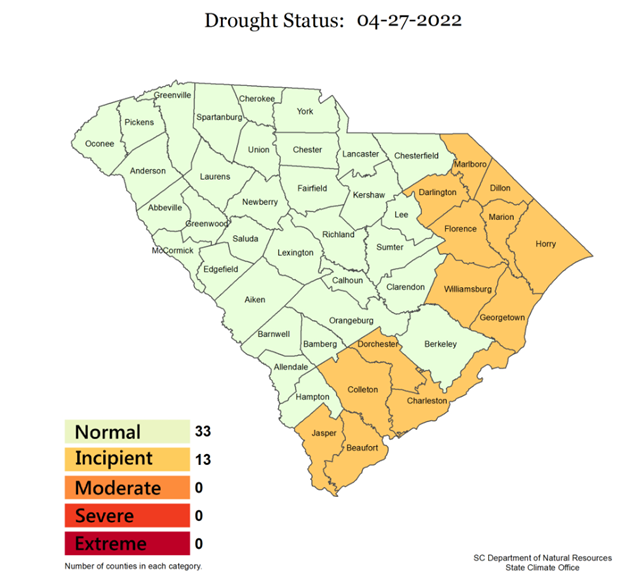SCDNR News
Darlington, Marlboro, Dillon counties added to ‘incipient’ drought declaration, Berkeley County removed
COLUMBIA, S.C.
April 27, 2022

The S.C. Drought Response Committee, meeting via conference call on April 27, added Darlington, Marlboro and Dillon counties to the ‘incipient’ drought declaration already in place for some counties. The drought declaration was removed from Berkeley County and maintained for 10 counties (see map).
As designated by the South Carolina Drought Response Act, Incipient is the first level of drought followed by Moderate, Severe, and Extreme. Below normal topsoil and subsoil moisture were the primary driving factors leading to the drought declaration. The Committee also based its decision on recommendations from several farmers, Farm Service Agency and the S.C. Department of Agriculture.
The 13 counties now included in the Incipient drought status are: Beaufort, Charleston, Colleton, Darlington, Dillon, Dorchester, Florence, Georgetown, Horry, Jasper, Marion, Marlboro and Williamsburg.
Producers in Darlington County stated that it is unseasonably dry. According to Amy Blum, county executive director of Darlington County Farm Service Agency, very few rain showers have only brought tenths of inches of rain over the previous weeks. With temperatures increasing and constant high wind speeds, the short showers received in Darlington County have evaporated before they were able to leach into the soil.
Marlboro County farmers are currently facing dry conditions with about 5 inches of rainfall since the beginning of March and are preparing for a dry year. Robin B. Hudson, county executive director of Marlboro County Farm Service Agency, reported that without moisture in the coming weeks, planting will be affected. While cotton acreage can stand some dry weather at planting, soybeans, vegetables and other spring planted crops need moisture at planting. The dry weather will also affect corn, tobacco and other crops that have been planted in recent weeks and are in active growth. At this time, planting is continuing, but will soon slow or possibly halt without rain.
Wildfire fuel conditions have improved with the recent rainfall and the “green-up” when new growth develops should decrease wildfire occurrence in late April and early May. But if an extended dry period occurs, activity may increase in the early summer months, explained Darryl Jones, forest protection chief for the S.C. Forestry Commission. The spring wildfire season in South Carolina has been active with higher-than-normal number of wildfires and acres burned, compared to the state 10-year averages.
Priyanka More, S.C. Department of Natural Resources (SCDNR) hydrologist, provided an update of the hydrologic conditions summarizing that rainfall received in March and April was beneficial for streamflows, lake levels, and groundwater in the state and relieved extreme low streamflows at Little Pee Dee and Waccamaw gauges in Horry County. However, the past dryness has caused flows at some gauges in the coastal areas to remain below their medians, therefore supporting the retaining of Incipient status.
The Committee decided April’s rainfall was not enough to overturn the incipient drought declaration that was in place for Beaufort, Charleston, Colleton, Dorchester, Georgetown, Horry, Florence, Jasper, Marion and Williamsburg counties. The Committee removed the Incipient declaration for Berkeley County due to reports of 6 to 8 inches of rain over the last 30 days. Elsewhere in the state, rainfall has been 100 to 300 percent of normal since April 1.
The South Carolina Drought Response Committee will continue to monitor conditions moving through the spring and will reconvene as needed.
Media Contact:
Hope Mizzell, SCDNR State Climatology Office, MizzellH@dnr.sc.gov
Priyanka More, SCDNR Hydrology, morep@dnr.sc.gov
Rob Devlin, SCDHEC, Devlinrj@dhec.sc.gov
Darryl Jones, S.C. Forestry Commission, djones@forestry.state.sc.us
Chad Truesdale, S.C. Department of Agriculture, ctruesd@scda.sc.gov



